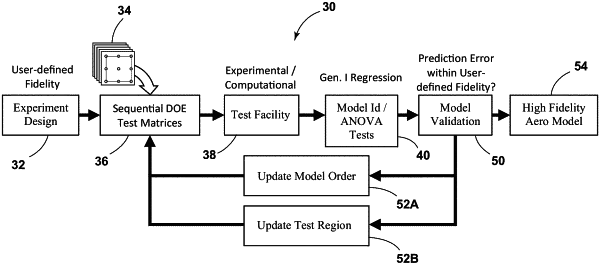| CPC G06F 30/15 (2020.01) | 20 Claims |

|
1. A computer-implemented method of creating a polynomial aerodynamic model that predicts forces on an aerodynamic body corresponding to the polynomial aerodynamic model, the method comprising:
determining fidelity criteria for an aerodynamic model, wherein the fidelity criteria comprise a plurality of maximum allowable prediction errors;
causing a computer program to form validation data utilizing selected factors that vary during flight;
a) causing the computer program to form a series of sequential scalar test blocks utilizing selected factors that vary during flight and predefined sequential non-scalar test blocks stored in a library, wherein at least some of the factors comprise ranges that are capable of being split, wherein the series of sequential scalar test blocks correspond to aerodynamic models having increasing order;
b) applying the series of sequential scalar test blocks to a computational fluid dynamics (CFD) program to produce response data;
c) estimating an aerodynamic model utilizing the response data, wherein the aerodynamic model comprises a plurality of aerodynamic polynomials;
d) utilizing predefined prediction error criteria and the validation data to determine if an aerodynamic model estimated from the response data satisfies pass-fail validation criteria;
if the aerodynamic model does not satisfy the pass-fail criteria, repeating steps a)-d) utilizing scalar test blocks of increasing order until a last sequential scalar test block has been used, followed by splitting one or more factors to form at least one test region if the pass-fail criteria is not satisfied using the last sequential scalar test block followed by repeating steps a)-d) utilizing at least one test sub-region; and
e) applying the aerodynamic model satisfying the pass-fail validation criteria to an aerodynamic vehicle in a wind tunnel, a simulation study, a real-time simulation, or a design process.
|